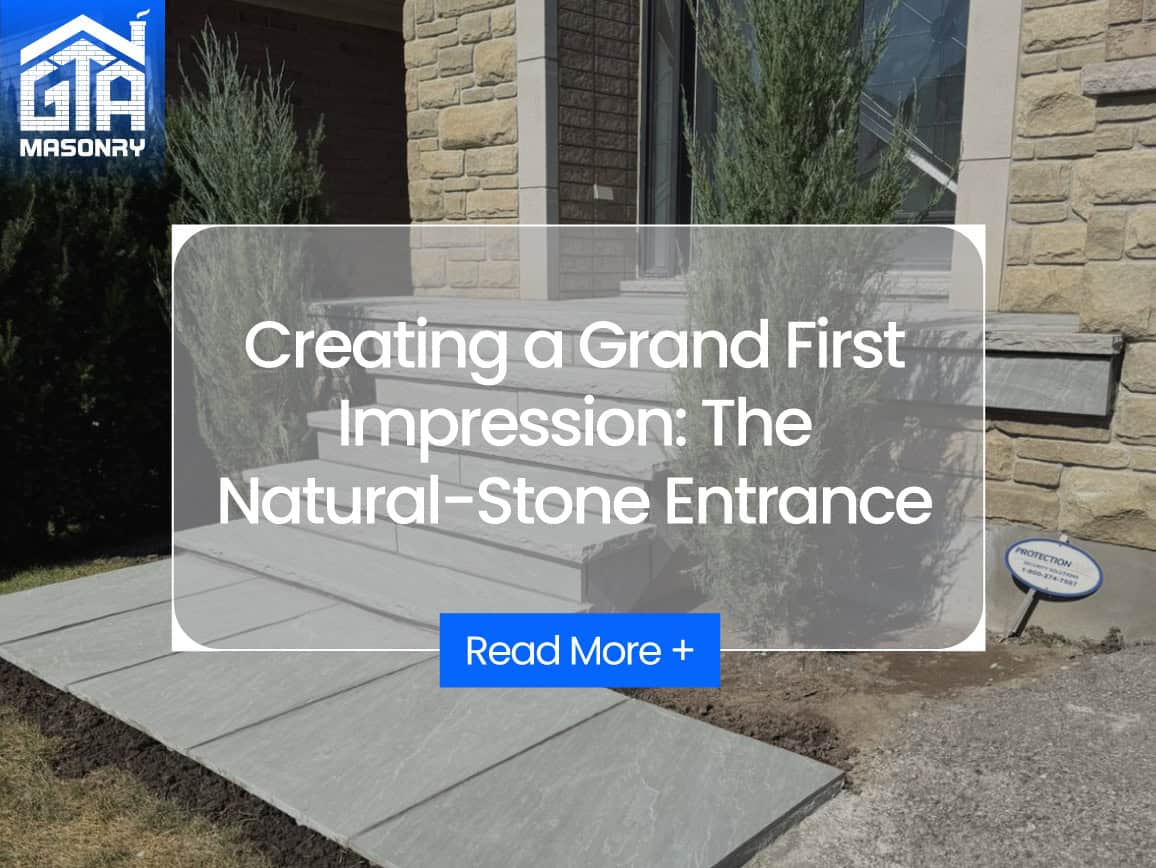The Impact of Winter Weather on Your Masonry—and How to Prevent Damage
Toronto winters are hard on brick, stone, and mortar. Repeated freeze–thaw cycles, wind-driven snow, de-icing salts, and poor drainage can turn tiny cracks into major failures by spring. The good news: most winter-related masonry damage is predictable and preventable when you know what to look for and how to prepare. This guide explains what winter does to masonry, how to spot problems early, and the smartest steps to protect your home.
How Winter Affects Masonry
1) Freeze–Thaw Cycling (Spalling)
Moisture enters hairline cracks and porous faces. When temperatures drop below freezing, water expands by ~9%, exerting pressure on brick faces and mortar joints. Over many cycles, this causes spalling (flaking or popping faces), widened cracks, and loose units.
2) Moisture Penetration & Efflorescence
Snowmelt and rain can wick through capillaries in brick and mortar. As moisture migrates outward, it carries dissolved salts to the surface; when the water evaporates, it leaves a white, chalky deposit (efflorescence). While mostly cosmetic, efflorescence signals ongoing water entry that accelerates freeze–thaw damage.
3) Frost Heave Under Flatwork
Water trapped beneath patios, walks, and steps freezes and expands, lifting pavers and slabs. When thaw comes, surfaces settle unevenly, leaving lip hazards and open joints where more water can enter.
4) Mortar Joint Degradation
Mortar weathers faster than brick or stone. In winter, saturated joints soften and crack. Once joints open, the wall admits more water, compounding the cycle and inviting drafts and interior moisture staining.
5) Chimney & Parapet Distress
Chimneys and exposed parapets take the brunt of winter weather. Failed crowns, cracked caps, and compromised flashing let water in from above; freeze–thaw then widens cracks, loosens bricks, and can push entire sections out of alignment.
6) Salt & De-Icer Damage
Chloride-based de-icers can draw moisture into masonry and attack cement paste, causing scaling and accelerated surface loss—especially on limestone, concrete steps, and mortar.
Early Warning Signs to Catch Now
- New hairline cracks in brick faces, corners, or step risers
- Crumbling, recessed, or missing mortar (especially near grade)
- Flaking or “popped” brick faces (spalls) below sills and caps
- White, chalky efflorescence streaks—often below leaky copings, sills, or caps
- Drafty or damp interior walls adjacent to exterior masonry
- Heaved, rocking, or uneven pavers and icy puddles on walks
- On chimneys: cracked crown, loose cap stones, rust-stained flashing, or missing mortar
Pre-Winter Protection Checklist
Addressing small issues in late fall prevents major repairs in spring. Prioritize the steps below.
1) Seal the Envelope
- Repoint failed mortar joints. Sound joints keep water out and bricks tight. For cracked or missing mortar, schedule masonry crack repair before sustained freeze.
- Repair caps and copings. Reset loose stones; add drip edges where missing. The top surfaces are your first roof against water.
- Consider a breathable water-repellent. A professional-grade silane/siloxane penetrant reduces absorption without trapping moisture (avoid film-forming sealers on vertical walls).
2) Manage Water
- Gutters & downspouts: Clean thoroughly; extend outlets at least 6–10 ft from the foundation. Do not discharge near patios, stairs, or retaining walls.
- Grade: Maintain positive slope away from walls. Keep landscaping below the brick line to protect weep paths and flashing.
- Flatwork drainage: Add channel drains or re-slope problem areas where ice sheets form.
3) Chimney Tune-Up
- Inspect the crown: Seal hairline cracks or replace deteriorated crowns to keep water out of the flue chase.
- Check flashing: Repair rusted or open seams where chimney meets roof.
- Install or replace a cap: A properly sized chimney cap blocks snow and driving rain and deters wildlife. For repairs or full restorations, book professional chimney repair services before deep freeze.
4) Patio, Walkway & Step Prep
- Re-level rocking pavers and fill open joints with polymeric sand before temperatures drop.
- Switch to sand or calcium-magnesium acetate on stone surfaces; avoid sodium chloride on limestone and concrete.
- Seal dense stones and concrete with an exterior-rated, breathable penetrant to reduce salt and moisture intrusion.
Cold-Weather Do’s & Don’ts
- Do clear snow promptly with plastic shovels on stone steps to avoid scratching and salt use.
- Do keep downspout extensions unfrozen and discharge points clear of ice dams.
- Don’t apply interior-grade or film-forming sealers to exterior brick—they trap moisture and can cause scaling.
- Don’t chip ice with metal tools on stone treads; use sand for traction until warmer temps allow a safe melt.
Repair Options
Repointing & Brick Replacement
Where mortar has receded or failed, targeted repointing restores weather resistance. Spalled bricks should be replaced in-kind and the water source above (coping, sill, or flashing) corrected.
Crack Stitching & Lintel/Sill Corrections
Stair-step cracks near openings often indicate lintel corrosion or deflection. Replacing or re-coating lintels and stitching cracks prevents further movement and water ingress.
Chimney Restoration
Typical work includes crown rebuilds, flue cap installation, selective brick replacement, and new step/flange flashing. If moisture entry has stained nearby interiors, act quickly—the damage compounds each freeze–thaw cycle.
Flatwork Re-Leveling
Heaved or settled paving should be lifted, base corrected with free-draining aggregate, and units reset with proper slope. Add edge restraints and drainage to prevent recurrence.
Frequently Asked Questions
How often does freeze–thaw matter in the GTA?
Toronto typically sees dozens of freeze–thaw swings each winter. Even micro-cracks can multiply quickly under those conditions, making fall maintenance crucial.
Is winter a good time to do masonry work?
Minor emergency stabilizations are possible in cold weather, but most durable repairs—repointing, brick replacement, crown rebuilds—should be scheduled when temperatures allow proper curing. Book early; spring calendars fill fast.
What’s the safest de-icer for stone?
Use sand for traction and, when necessary, calcium-magnesium acetate (CMA). Avoid sodium chloride on limestone, concrete, and mortars.
When should I call a professional?
Major cracks, bulging walls, loose bricks, persistent leaks, chimney crown failure, or repeated frost heave are all reasons to bring in specialists. Early intervention saves money and prevents safety hazards.
Why Choose GTA Masonry
We combine traditional craftsmanship with modern building-science detailing tailored to Ontario winters. From targeted repointing and unit replacement to chimney restoration and drainage-first hardscape corrections, we solve the cause—not just the symptom—and stand behind the work.
Next Steps
- Book a pre-winter inspection to address small issues before they expand.
- Prioritize chimneys, copings, sills, steps, and any wall faces that already show staining or cracking.
- Plan spring projects early if temperatures are already below ideal curing ranges.
Protect your investment this winter. For expert diagnostics, preventive maintenance, or repairs, contact GTA Masonry. Start with focused masonry crack repair where needed, and schedule comprehensive chimney repair services to keep water out for good.
Get your Masonry Project completed with GTA Masonry for dreamy results you wont be able to stop admiring.






Hours of Operation
Monday - Sunday
8:00 AM - 8:00 PM

